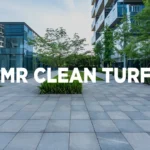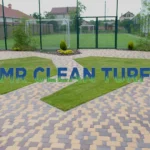Rubber Pavers | A Game-Changer for Playgrounds and Walkways
The rubber paver system acts as an environmentally conscious flooring material made from scrap tire products. Rubber pavers currently revitalize playground areas and walkways because they add safety elements without compromising their reliable performance and simplified maintenance system. The rubber paver surface combination demonstrates superior capabilities compared to traditional materials through its safe and skid-resistant rough texture designed for popular usage zones.
Due to their superior durability, rubber pavers should be installed in areas where children play and paths where people walk since they see frequent traffic usage. Rubber items stay cool under sunlight because they have higher absorption, whereas concrete pavers or brick pavers develop excessive heat. Property safety features of rubber pavers establish them as the top material for school defense systems as well as park and residential protection.
The installation system operates through interlocking elements, enabling easy and quick procedures to decrease operational costs and installation length.
Why Choose Rubber Pavers?
The practical application of rubber pavers creates an option that defends walkways and playgrounds from damage. The combination of security features and extended life span, together with low upkeep needs, gives pavers superiority over traditional materials. Present-day property owners use pavers because their distinctive features enable better playground and walkway project design.
Safety First for Playgrounds
The safety of playgrounds remains the highest priority for parents and planners, together with other involved stakeholders. Rubber pavers excel at impact absorption; therefore, they protect children from accidents better than concrete or brick pavers. ASTM safety standards authorize pavers to work in applications that include educational facilities and recreational parks. Children benefit easily from using this compliant surface because its cushioned area lowers their risk of injuries during playtime.
Perfect for Walkways
The appropriate walking surface must remain intact but actively prevent accidents that result from slipping occurrences. At temperatures ranging between -40°F and 220°F, pavers perform effectively in extreme weather before showing any signs of cracking that would affect travertine and granite pavers. Tracked surfaces from textured pavers ensure overall weather safety by maintaining surface friction. The installation process creates a level walking area using these pavers, which disrupts the surface in no way.
Comparing Pavers: Which Material Fits Your Needs?
Three essential components determine your selection process: material durability as well as budget and maintenance requirements. Modern pavers have gained notable market expansion despite traditional concrete and brick pavers maintaining their market leadership. Your decision process requires an evaluation of the advantages and disadvantages of these options.
Category |
Material |
Pros |
Cons |
| Traditional Options | Concrete Pavers | Affordable | This material tends to crack during periods of cold temperatures. |
| Brick Pavers | Classic, timeless look | Require frequent upkeep | |
| Flagstone Pavers | Natural appearance | Uneven surfaces can trip users | |
| Modern Alternatives | Composite Pavers | Eco-friendly (a blend of wood and plastic) | Fade over time |
| Cobblestone Pavers | Extremely durable | Uncomfortable for long walks | |
| Granite Pavers | Strong and elegant | Expensive and heavy to install |
Rubber pavers outperform these options with their flexibility, low maintenance, and cost-effectiveness.
How Rubber Pavers Improve Safety and Accessibility
Public facilities, together with playgrounds and walkways, choose rubber pavers because they offer effective accessibility features during their design. The special characteristics of rubber pavers create a protected environment that welcomes every user, including young people and users with disabilities. The following sections explain which areas pavers demonstrate superior performance.
Impact Absorption
The safety factor of rubber pavers comes from their ability to absorb 90% of impact during falls, which matches the protective requirements of ASTM F1292 playground standards. The shock-absorbing capabilities of pavers surpass those of wood or composite pavers because they absorb 90% of impact compared to their counterparts. This material provides significant shock absorption, which benefits playgrounds due to frequent incidents of falling.
ADA Compliance
The ADA-approved flat and seamless appearance of pavers provides wheelchair and stroller accessibility because they do not have the hazardous bumps found in cobblestone or flagstone pavers. Rubber pavers create spaces that allow all users, including people with disabilities, to access facilities because of their ADA-compliant flat design.
Installation Made Simple
The process of rubber paver installation fits both home improvement novices and expert professionals. Serious building projects along with casual walkway renovations have equal flexibility when using rubber pavers because their installation methods are versatile. Several choices exist for you to select an installation approach that meets your requirements best.
DIY-Friendly Design
Rubber pavers come with interlocking tile designs, requiring a utility knife and mallet as the only essential tools needed for installation. No need for heavy machinery, unlike granite or travertine pavers. People who want to save installation expenses yet maintain professional outcomes should select rubber pavers as their installation solution.
Professional Installation Benefits
When working with big projects, professionals establish proper base preparation involving permeable gravel layers to promote drainage and increase lifespan. Their specialized knowledge produces a flat, durable flooring surface that stands up to intensive usage, thus making it suitable for commercial buildings and heavy traffic environments.
Cost Comparison: Rubber vs. Traditional Pavers
People must look at initial investment costs and future monetary benefits when they select their pavers. The dual benefit of long service life and minimal upkeep makes pavers provide better cost efficiency than traditional pavers, even with their higher initial investment. Reading this analysis will aid your decision by observing the price differences.
Category |
Material |
Upfront Cost (per sq. ft) |
Long-Term Savings |
| Rubber Pavers | Rubber Pavers | 8–15 | Rubber pavers provide at least ten to twenty years of service without needing any new applications of sealant or repairs. |
| Traditional Pavers | Concrete Pavers | 3–10 | Require repairs within 5–10 years |
| Brick Pavers | 10–20 | Require repairs within 5–10 years |
Eco-Friendly Advantages
The implementation of rubber pavers represents an economical solution that preserves respect for the environment. The following advantages make pavers environmentally beneficial for the planet:
Made from Recycled Materials
- Rubber pavers exist as a product that incorporates 50–75% recycled rubber materials from discarded tires.
- Every 1000 square feet of rubber paver installation reserves between two and three tons of rubber waste from reaching landfills.
100% Recyclable
- After their natural life span, pavers experience complete recycling, thus decreasing material waste.
- Rubber pavers demonstrate a longer lifespan than both asphalt and composite pavers because they do not typically end up in landfill spaces.
Reduces Carbon Footprint
- The production process of rubber pavers requires less energy than both concrete and brick paver production practices.
- The disposal of tires creates significant environmental problems, but pavers serve to decrease these adverse effects on the environment.
Durable and Long-Lasting
- The extended 10–20-year lifespan of pavers requires less material replacement, thus minimizing resource usage with each passing year.
Permeable Design
- Rainwater passes easily through the pavers because of their design, which reduces floodwater and replenishes underground water reserves.
- The proper drainage from rubber pavers creates a positive impact on natural ecosystems by preventing flooding and erosion.
Using pavers brings you both elegant surfaces and promotes sustainable operations, which help the environment.
Maintenance Tips for Longevity
- Regular rinsing once a month will clear away accumulated dirt from the surface.
- The application of harsh chemicals should be avoided because they will damage the property surfaces.
- The base layers should be leveled when shifting occurs, but this phenomenon remains rare with interlocking designs.
Conclusion
Safety-conscious and environmentally friendly pavers represent the smart selection for playgrounds together with walkways. Rubber pavers perform better than concrete or brick pavers in terms of longevity while providing users with safety. Rubber pavers maintain unparalleled value for every project type because they have an eco-friendly structure combined with low upkeep needs and extreme weather resistance.
Both residential play spaces intended for children and high-traffic walkways can benefit from rubber pavers because they provide exceptional performance with attractive design options. Modern landscaping demands pavers because they offer flexibility combined with extended economic benefits.
The time is now to start working with Mr. Clean Turf for top-tier rubber pavers that offer safety with style and economic value. Contact Mr. Clean Turf now for high-quality pavers that blend security factors with beauty at affordable costs.



